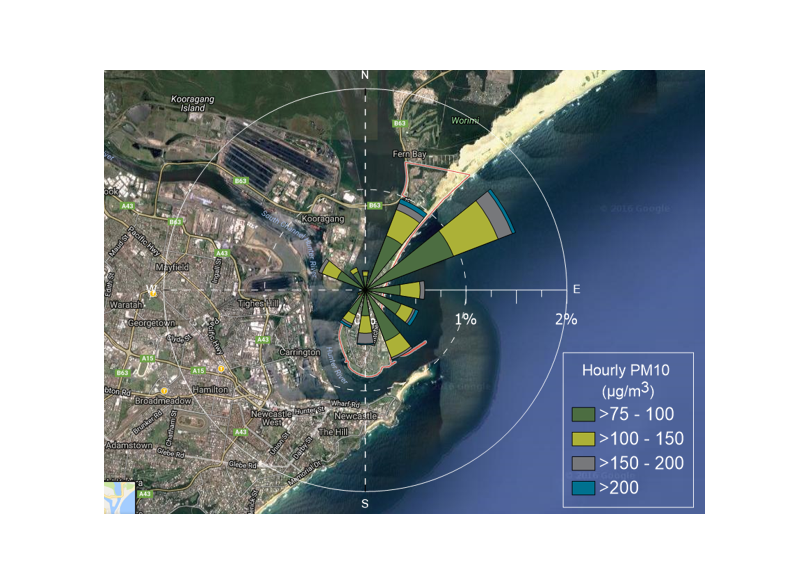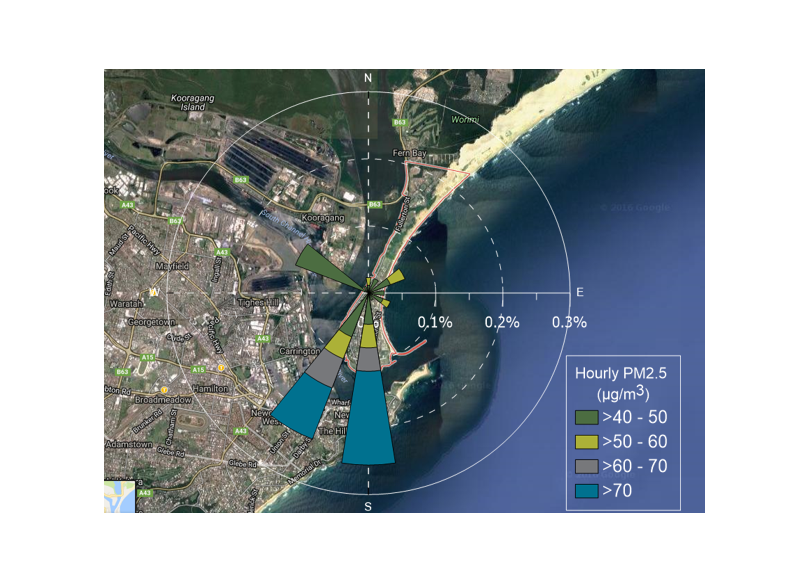Summary
The Stockton air quality monitoring station is part of the industry-funded Newcastle Local Air Quality Monitoring Network, focused around the Port of Newcastle. The station is approximately 300 metres from the ocean and 20 metres from Hunter River. Due to its proximity to the coast, high PM10 particle levels recorded at Stockton most often occur under onshore north-easterly winds. The Lower Hunter Particle Characterisation Study found that the largest contribution to PM10 at Stockton was sea salt.
Due to the proximity of industrial sources, the national ambient air quality standards do not apply directly to the data collected at these monitoring stations. However, the government recognises the community’s interest in knowing how air pollution levels at these stations compare against the standards. Therefore, this section refers to national standards as national benchmarks when evaluating air quality data throughout Stockton.
PM10 particles
For PM10, in 2020:
- The daily PM10 particle levels at Stockton were over the national benchmark of 50 µg/m3 on 55 days (compared with 102 days in 2019). Stockton typically records the most days exceeding the PM10 benchmark across the NSW air quality monitoring network, due to the station’s exposure to sea salt in onshore winds.
- The PM10 annual average reached 34.5 µg/m3 (compared to 43.6 µg/m3 in 2019), the highest in New South Wales and the only annual record exceeding the national benchmark of 25 µg/m3 in 2020.
- Most of the days exceeding the PM10 standard at Stockton (44 days, 80% of the annual total) occurred in the warmer months of January to March and October to December, when onshore winds typically prevail and sea salt contribution increases. In January, when PM10 levels were over the daily benchmark on 16 days (29% of the annual total), the region also was greatly affected by long-range dust transport and extensive bushfire smoke during the severe drought and bushfire emergency period.
- Elevated hourly PM10 levels (>75 µg/m3, an indicative level as there is no standard for hourly PM10) occurred 6.5% of the time over the year, as shown in the PM10 pollution rose below. These elevated hourly PM10 levels occurred under:
- onshore north-easterly to south-easterly winds for 65% of hours with elevated PM10 (4.2% total time for the year), indicating the potential contribution of sea salt
- north-west winds for 10% of hours with elevated PM10 (0.6% total time for the year).
- During 2020, the NSW Government began reporting against an hourly PM10 threshold of 100 µg/m3. At Stockton, hourly PM10 levels exceeding 100 µg/m3 occurred 2.4% of the time over the year. These levels occurred under:
- onshore north-easterly to south-easterly winds for 65% of hours when PM10 was over 100 µg/m3 (1.6% total time for the year)
- north-west winds for 9% of hours when PM10 was over 100 µg/m3 (0.2% total time for the year).
PM2.5 particles
For PM2.5 in 2020:
- The daily PM2.5 particle levels at Stockton were over the benchmark of 25 µg/m3 on 4 days (compared with 27 days in 2019).
- The PM2.5 annual average exceeded the benchmark of 8 µg/m3, reaching 9.3 µg/m3 (compared to 13.0 µg/m3 in 2019).
- All PM2.5 events at Stockton occurred in January, during the bushfire emergency period.
- Elevated hourly PM2.5 levels (>40 µg/m3, an indicative level as there is no standard for hourly PM2.5) occurred 0.8% of the time over the year, as shown in the PM2.5 pollution rose below. These levels occurred under north-west winds for 16% of hours with elevated PM2.5 (0.1% of time for the year).
- During 2020, the NSW Government began reporting against an hourly PM2.5 threshold of 50 µg/m3. At Stockton, hourly PM2.5 levels exceeding 50 µg/m3 occurred 0.4% of the time over the year. These levels did not occur under north-west winds.
Local industrial sources also contribute to particle levels at Stockton, under north-west winds. The Lower Hunter Particle Characterisation Study found that Stockton PM2.5 levels in winter, under north-west winds, were influenced mainly by direct emissions of ammonium nitrate particles from industry, located approximately 1 kilometre to the north-west, on Kooragang Island.
Hourly ammonia (NH3) levels were below the assessment goal of 46 pphm at Stockton throughout 2020. The maximum hourly NH3 level was 30.3 pphm, recorded on 16 June 2020. The annual average ammonia level was 1.4 pphm.
For more information on seasonal air quality at Stockton, refer to the Newcastle seasonal newsletters.

Stockton hourly PM10 levels exceeding 75 µg/m3 in relation to wind direction – 2020.

Stockton hourly PM2.5 levels exceeding 40 µg/m3 in relation to wind direction – 2020